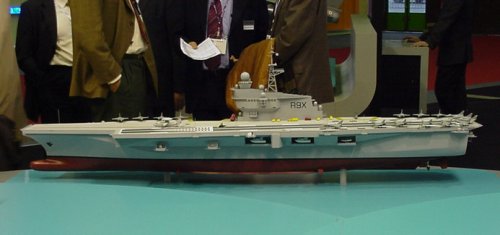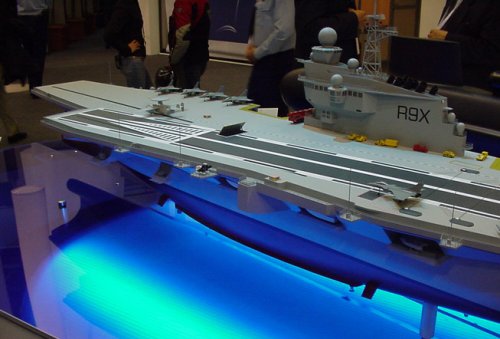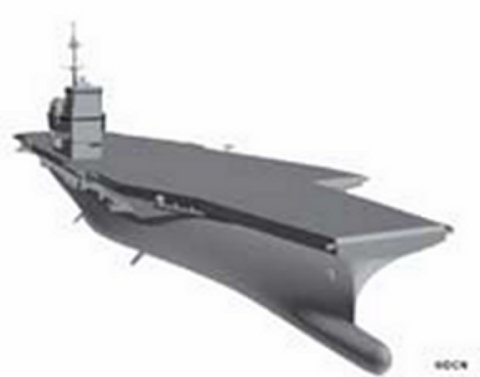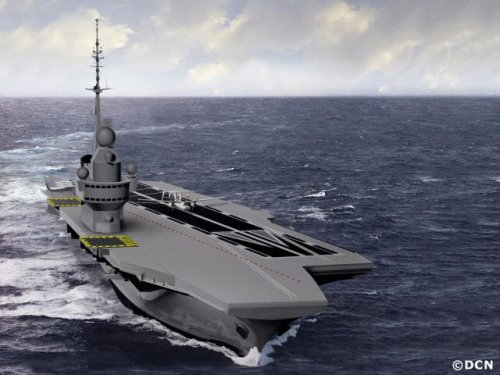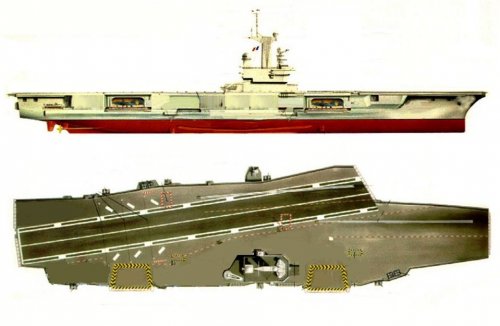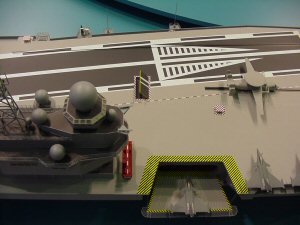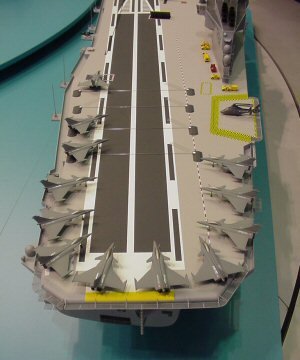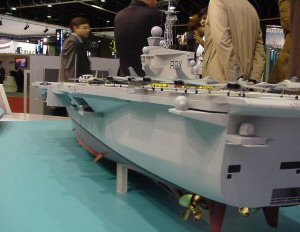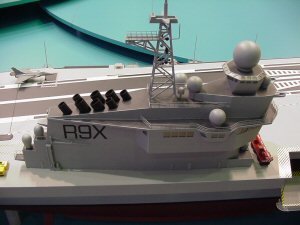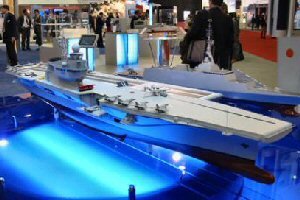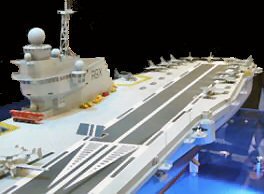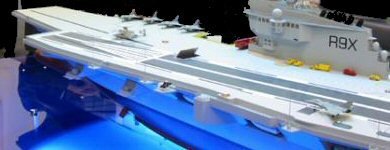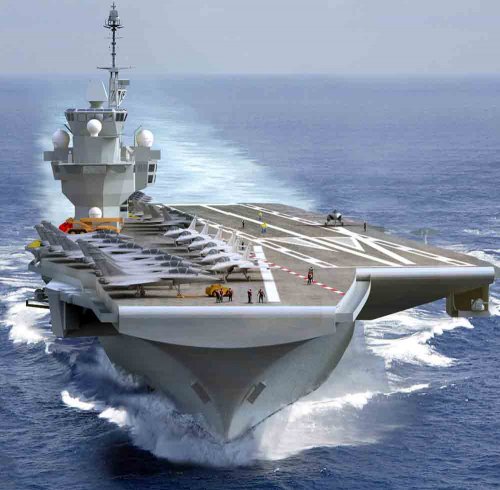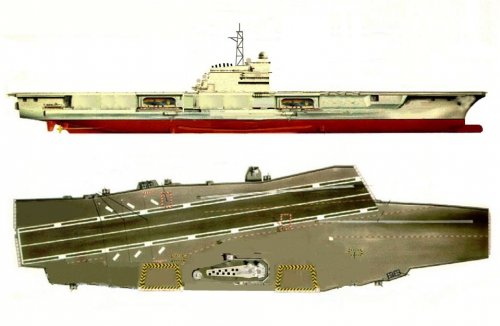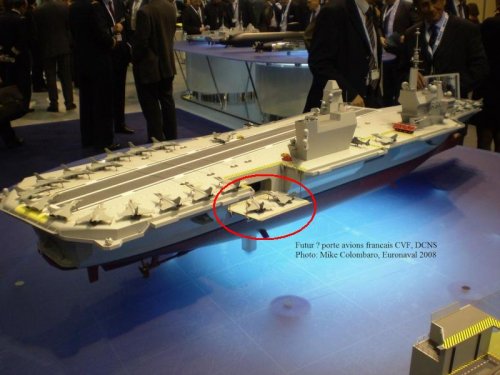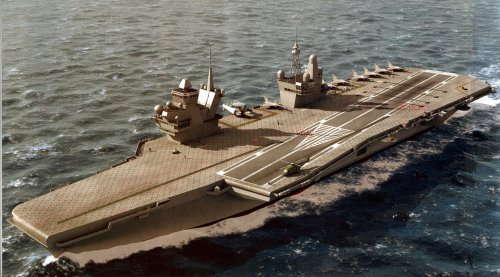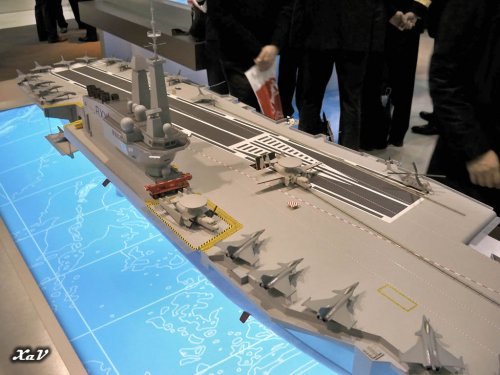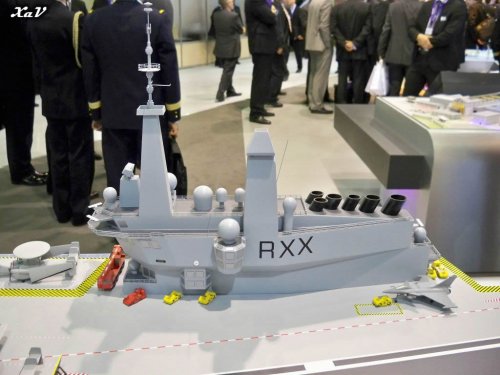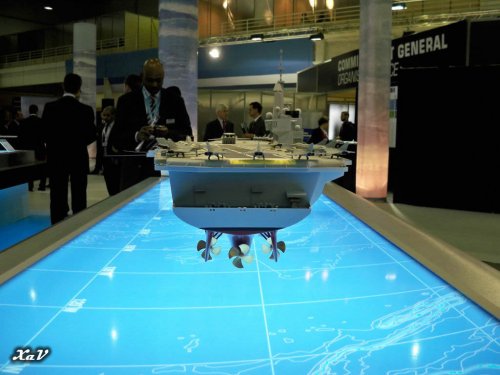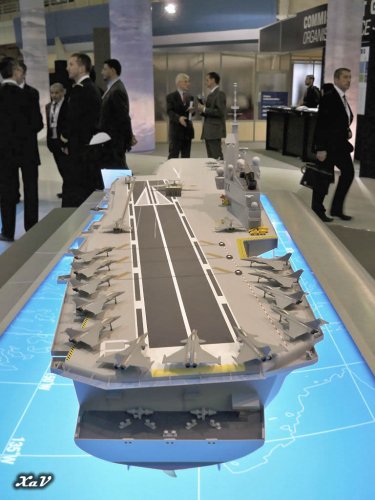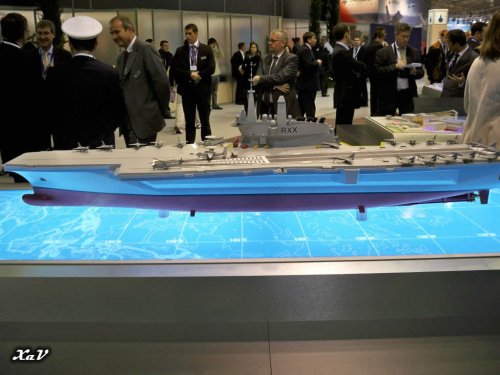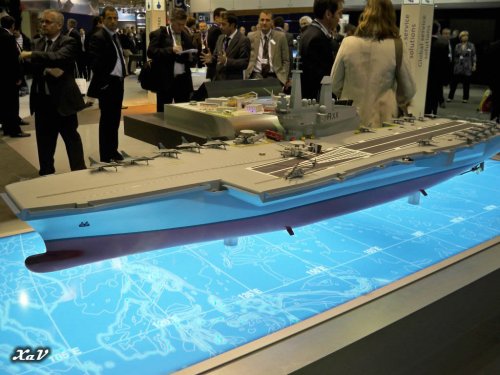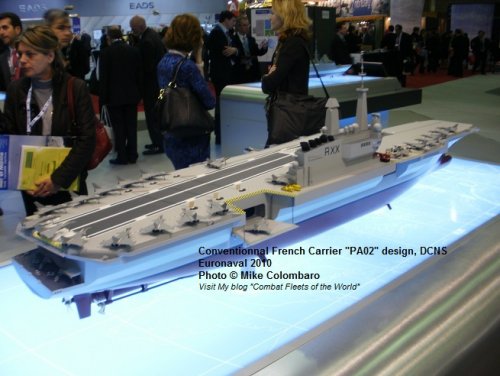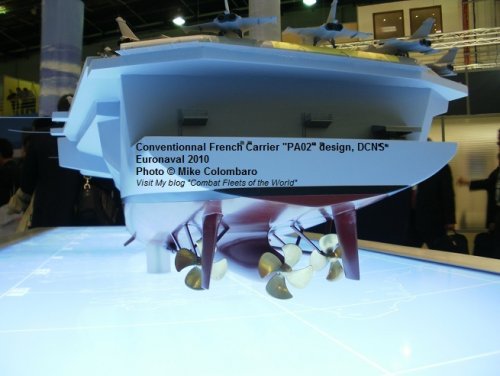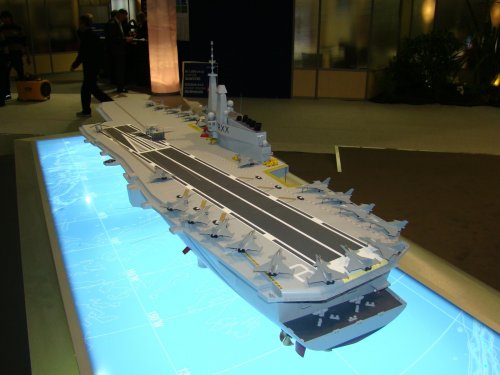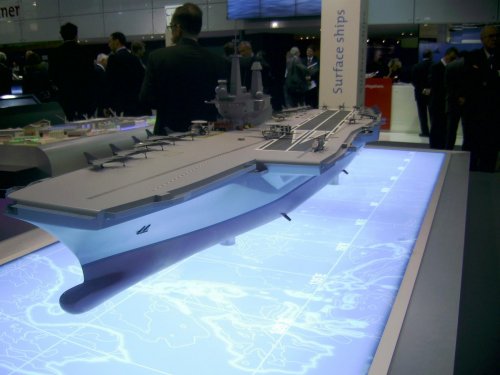You are using an out of date browser. It may not display this or other websites correctly.
You should upgrade or use an alternative browser.
You should upgrade or use an alternative browser.
PA NG - next gen French Aircraft carrier program
- Thread starter JAZZ
- Start date
A
avatar
Guest
these might be considered for IAC 2-3 as the Indian navy is looking at much larger carriers in the future
DCN/Thales PA2 "Projet Juliette" concept.
Images 1-3 are from a model at the DCN booth displayed at Euronaval 2004 in October 2004.
Images 4-7 are from a model at the Thales booth displayed at Euronaval 2004 in October 2004.
Images 1-3 are from a model at the DCN booth displayed at Euronaval 2004 in October 2004.
Images 4-7 are from a model at the Thales booth displayed at Euronaval 2004 in October 2004.
Attachments
IMO aesthetically she resembles the Foch/Clemenceau rather than CGN, the island being in the more central position.
What was the intended powerplant, from the number of exhausts I would guess Gas Turbines?
What was the intended powerplant, from the number of exhausts I would guess Gas Turbines?
JohnR said:IMO aesthetically she resembles the Foch/Clemenceau rather than CdeG, the island being in the more central position.
What was the intended powerplant, from the number of exhausts I would guess Gas Turbines?
HeavyG
ACCESS: Confidential
- Joined
- 21 August 2009
- Messages
- 80
- Reaction score
- 18
I think all of these variants are going to fall by the wayside...I believe the French are cooperating with the British. The most likely design will be a variant of the new Queen Elizabeth class which the British just started building.
- Joined
- 2 January 2006
- Messages
- 659
- Reaction score
- 283
HeavyG said:I think all of these variants are going to fall by the wayside...I believe the French are cooperating with the British. The most likely design will be a variant of the new Queen Elizabeth class which the British just started building.
The Freench did sign up for a CTOL version of the Thales CVF design and were looking at a joint build effort with the UK, however with the change in government, the PA2 however was droped from the first 5 yr budget and the UK pressed ahead with ordering CVF.
I suspect the CVF design will be revamped and revised once the French decide to start up the PA2 program again, possibly with Nuclear power as per CdG.
G
The Navy Matters web site discusses the evolution of the French Deuxième Porte-Avions (DPA) project:
http://frn.beedall.com/pa2-1.htm
http://frn.beedall.com/pa2-1.htm
colombamike
ACCESS: Restricted
- Joined
- 14 November 2009
- Messages
- 18
- Reaction score
- 4
some view of french PA 02, during euronaval 2008




- Joined
- 21 May 2006
- Messages
- 3,002
- Reaction score
- 2,280
colombamike said:some view of french PA 02, during euronaval 2008
Nice sized deck-edge lifts!
Attachments
- Joined
- 21 May 2006
- Messages
- 3,002
- Reaction score
- 2,280
HeavyG said:I think all of these variants are going to fall by the wayside...I believe the French are cooperating with the British. The most likely design will be a variant of the new Queen Elizabeth class which the British just started building.
Lets hope so for everyones sake!
Although I find it hard to believe that the French would not want control and biggest say in such a large project! (Not being derogatory to the French - its just past history I am reflecting on when it comes to joint military projects - especially with Britian!!)
Regards
Pioneer
Thank you for sharing your photographs columbamike.
Pioneer said:HeavyG said:I think all of these variants are going to fall by the wayside...I believe the French are cooperating with the British. The most likely design will be a variant of the new Queen Elizabeth class which the British just started building.
Lets hope so for everyones sake!
Although I find it hard to believe that the French would not want control and biggest say in such a large project! (Not being derogatory to the French - its just past history I am reflecting on when it comes to joint military projects - especially with Britian!!)
Regards
Pioneer
I think they tried, suggesting the hull be built at Brest. But seeing as steel has been cut and advance preparations made in the UK it's moot. IMHO the most economical thing for the French would be to let the UK build the hull, then fit it out in France, much as they did with the Mistral. But somehow I do not think the French Unions would wear it.
Artist's impression of Deuxième Porte-Avions circa 2007.
Source: http://www.corlobe.tk/article4279.html
Source: http://www.corlobe.tk/article4279.html
Attachments
Model of DCNS PA2 concept on display at Euronaval 2010.
Source:
http://community.livejournal.com/grand_fleet/534881.html#cutid1
Source:
http://community.livejournal.com/grand_fleet/534881.html#cutid1
Attachments
- Joined
- 2 January 2006
- Messages
- 659
- Reaction score
- 283
It was interesting to see what the DCNS official spokesperson said about the PA2 design, he rattled off some bull about refining the Thales CVF design when its blatantly obvious they have just updated their Julliet concept and kicked Thales out of the design process. No doubt they are thinking of the Brazilian order and aim to have their own conventional carrier design on hand with the FREMM class in a similar way to BAE offereing the CVF potential with Type 26, as the French government still apears unlikely to authorise PA2 at this time.
G
G
westlife_100
ACCESS: Restricted
- Joined
- 8 December 2009
- Messages
- 3
- Reaction score
- 2
one island again? why? ???
- Joined
- 2 January 2006
- Messages
- 659
- Reaction score
- 283
westlife_100 said:one island again? why? ???
Because DCNS are pushing their revamped Julliet design, and this has just one Gas turbine along with diesels so the intakes and exhausts are all truncked together in to one island. The CVF design had two seperate engine rooms and thus the twin islands as opposed to one long one.
zen said:Just two lifts too? Or did I miss one?
Only the 300m plus sized carriers have more than two lifts. The CdG, CVF and PA2 designs have always had two lifts (except for the BAE CVF proposal that had three small F-35 sized lifts but that design was rejected)
This revamped PA2 design has some real strengths. The entire propulsion setup is very ingenious. The finer hull (longer waterline length) makes a 3-shaft layout possible, and this brings several important benefits.
Costs have been driven down 20%, which is huge. The propulsion improvements surely play a role in that.
That said, I would have preferred to see a hybrid propulsion setup with two diesel-electric shafts for cruise and a gas turbine directly driving a centreline sprint-optimized variable pitch propeller, since I think that would be even cheaper and mechanically simpler. Something along these lines - ideal for a carrier or fast amphib set-up.

Here's a size comparison of the latest PA2 design with CdG, CVF... and CVV!

- First, 3 shafts will be more efficient than 2 shafts (counter-intuitive, I know - the return-to-grace of 3-shaft arrangements seems to be driven by very recent advances in fluid dynamics).
- Second, 3 shafts require less reserve power margin to cover for contingencies such as damage to a propeller/shaft. This means fewer expensive electric motors and smaller, cheaper propellers.
- The net result is that PA2 can reach the same maximum speed as CVF on only 63MW instead of ~80MW. This eliminates the need for one gas turbine, which allows for the return to a single, more space efficient island.
Costs have been driven down 20%, which is huge. The propulsion improvements surely play a role in that.
That said, I would have preferred to see a hybrid propulsion setup with two diesel-electric shafts for cruise and a gas turbine directly driving a centreline sprint-optimized variable pitch propeller, since I think that would be even cheaper and mechanically simpler. Something along these lines - ideal for a carrier or fast amphib set-up.
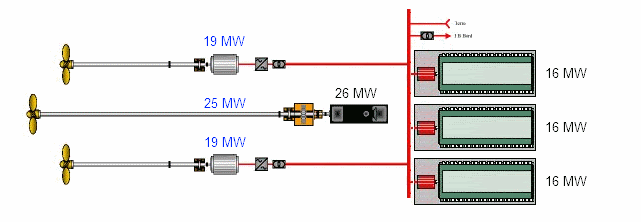
Here's a size comparison of the latest PA2 design with CdG, CVF... and CVV!
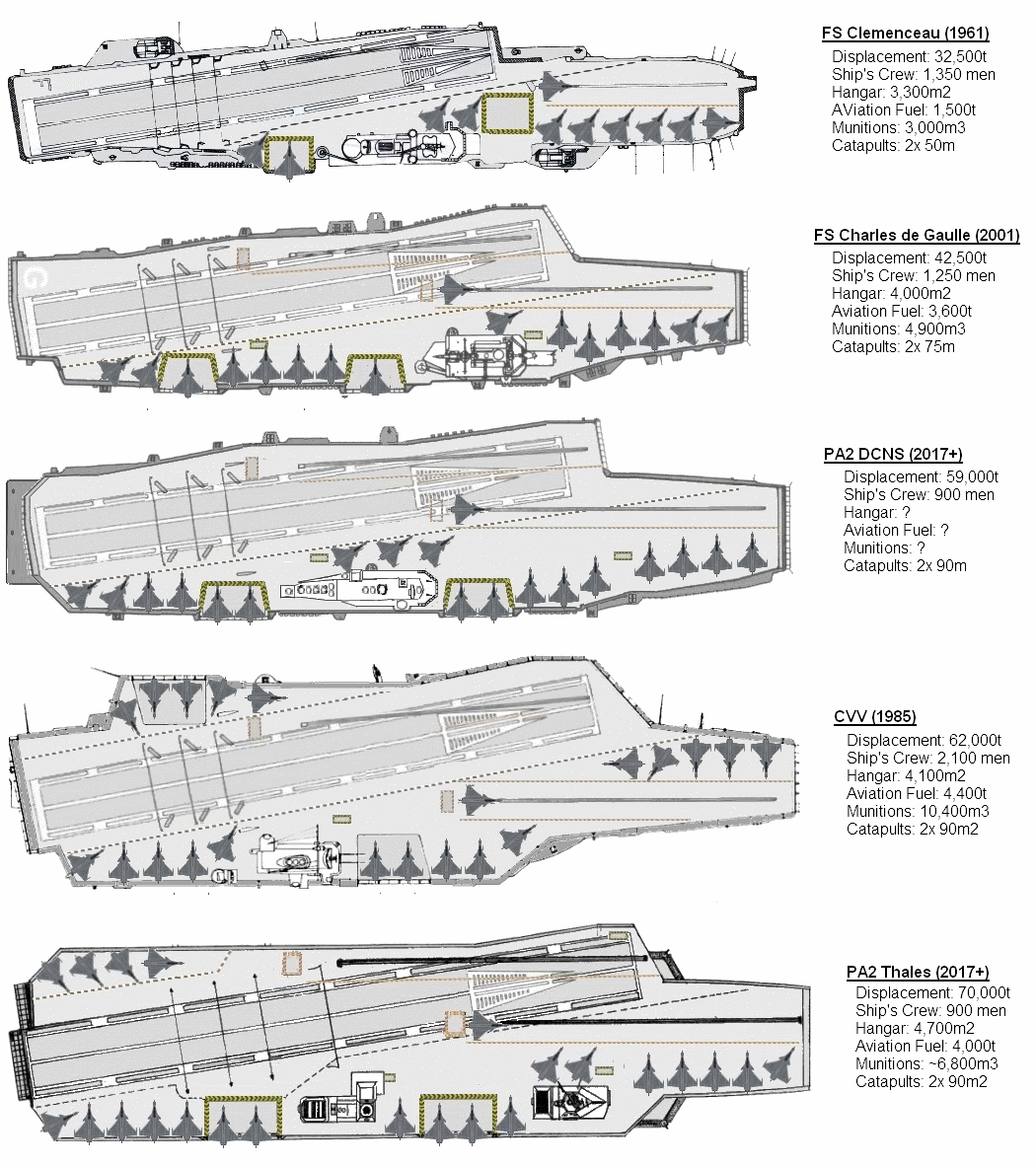
H_K said:
- First, 3 shafts will be more efficient than 2 shafts (counter-intuitive, I know - the return-to-grace of 3-shaft arrangements seems to be driven by very recent advances in fluid dynamics).
How so?
H_K said:
Specs for the lastest PA2 design (source : DCNS) :
Length overall (flight deck): 285 m
Beam overall (flight deck): 69 m
Displacement (start of life): 59,000 tonnes
Displacement (end of life): 62,000 tonnes
Draught (end of life): 10 m
Speed: 26 knots / > 20 knots on (n-1) shafts
Propulsion: electric
Endurance (with 30% reserve): 8,000 nm at 15 knots / 5,000 nm at 22 knots
Fuel oil capacity: 3,800 tonnes
Jet fuel capacity: 3,400 tonnes
Magazine (munitions): 800 tonnes
Hangar area: 4,800 m2
Accommodation: 1,690
Flight deck, area: 13,400 m2
http://en.dcnsgroup.com/naval/produits/la-famille-des-porte-avions/?product-category=porte-avions
H_K said:That said, I would have preferred to see a hybrid propulsion setup with two diesel-electric shafts for cruise and a gas turbine directly driving a centreline sprint-optimized variable pitch propeller, since I think that would be even cheaper and mechanically simpler. Something along these lines - ideal for a carrier or fast amphib set-up.

The new PA2 design by DCNS unveiled at Euronaval 2010 is 85 MW, of which 64 MW for propulsion.
The British CVF design is 108 MW, of which 80 MW for propulsion.
CDG is 61 MW for propulsion and another 21 MW for electric power.
According to the diagram above, installed power is 74 MW, of which 63 MW for propulsion. This won't be enough to generate the required 20+ MW required for electric power.
gral_rj said:H_K said:
- First, 3 shafts will be more efficient than 2 shafts (counter-intuitive, I know - the return-to-grace of 3-shaft arrangements seems to be driven by very recent advances in fluid dynamics).
How so?
Smaller propellers are more efficient, and the centerline propeller is set-back from the two others and thus benefits from their rotational energy. Wartsila claims installed power savings of ~7% from adding a centreline shaft: www.wartsila.com/Wartsila/global/docs/en/ship_power/media_publications/technical_papers/coded_machinery.pdf
Matt R. said:The new PA2 design by DCNS unveiled at Euronaval 2010 is 85 MW, of which 64 MW for propulsion.
The British CVF design is 108 MW, of which 80 MW for propulsion.
CDG is 61 MW for propulsion and another 21 MW for electric power.
According to the diagram above, installed power is 74 MW, of which 63 MW for propulsion. This won't be enough to generate the required 20+ MW required for electric power.
Interesting, do you have a source for the 85MW installed power on the latest PA2 design? AFAIK, the Euronaval press release only gave the size of the 3 electric motors: 63 MW (19MW x2 + 25MW).
Regarding my drawing, I wasn't showing the extra diesel-gensets needed for the hotel load, only the 3 diesel-gensets for propulsion. Re-reading DCNS' press release, it looks like there are no other diesel-gensets, which means the 3 diesel-gensets must be pretty darn big and the gas turbine genset probably an LM2500+G4. The hotel load requirement should be ~8MW (based on Cavour), which requires ~15MW to have some safety margin and make sure the diesels run at 90% maximum rating.
I've updated my drawing to reflect DCNS' "big diesel" layout, as best as I can guess. It doesn't make sense to me, because the big diesels have less power density and less redundancy than smaller diesels. I've drawn two alternative propulsion configurations:
- An option with high density diesels, which saves at least 400m3 of volume and fixes the redundancy issue, but will burn 2-3% more fuel.
- A hybrid-electric option, with mechanical drive train for cruise (14-16kts on 2 diesels, 18-20kts on 4 diesels, with a centreline variable pitch propeller on electric drive for sprints). This makes most sense for me, because it's very compact (~half the size of the "big diesel" option), at least as efficient (no electric transmission losses) and about 20-25 million euros cheaper due to the much smaller electric drivetrain
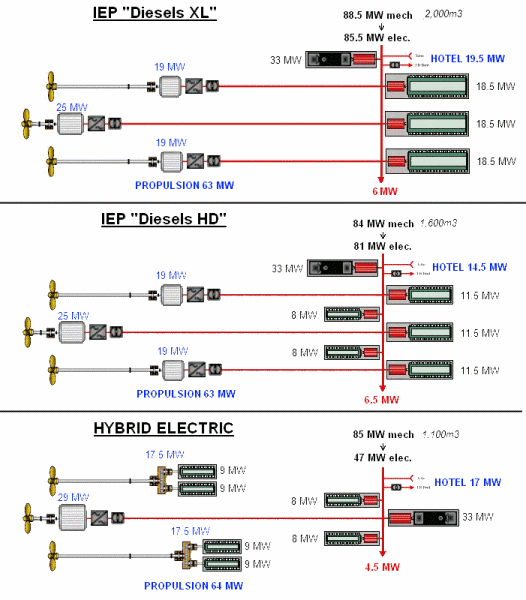
H_K said:Interesting, do you have a source for the 85MW installed power on the latest PA2 design? AFAIK, the Euronaval press release only gave the size of the 3 electric motors: 63 MW (19MW x2 + 25MW).
Source is this November 2010 article from Mer et Marine :
http://www.meretmarine.com/article.cfm?id=114409
"Le modèle présenté par DCNS et STX adopte une propulsion tout électrique, avec trois diesel-alternateurs, une turbine à gaz et trois moteurs électriques de propulsion. L'ensemble développe 85MW, dont 64 MW pour la seule propulsion, qui doit permettre au porte-avions de filer à 26 noeuds."
H_K said:I've updated my drawing to reflect DCNS' "big diesel" layout, as best as I can guess. It doesn't make sense to me, because the big diesels have less power density and less redundancy than smaller diesels. I've drawn two alternative propulsion configurations:
1) DCNS propulsion
If the article from Mer et Marine is correct, my guess is that DCNS propulsion is something like this :
a) GT is the LM 2500, i.e. 25 MW output.
b) Diesel engines are either the Colt-Pielstick PC4.2B (output = 20 MW @ 400 rpm) or the Wartsila 16V46F (output = 20 MW @ 600 rpm).
c) Total installed power = 1 * 25 MW + 3 * 20 MW = 85 MW
2) Your proposal entitled Diesel HD propulsion
If the same GT as above is kept, then the diesel engine combo would look like this :
a) 3 * Wartsila 12V38 @ (output = 8.7 MW @ 600 rpm)
b) 3 * Wartsila 16V38 (output = 11.6 MW @ 600 rpm)
c) Total installed power = 1 * 25 MW + 3 * 11.6 MW + 3 * 8.7 MW = 85.9 MW
3) Footprint
As I understand it, the footprint (L x B in m^2) is more relevant than the volume (L x B x H in m^3) you've used to compare the alternatives.
a) In the DCNS design, the footprint for the diesel engines alone is about 180 m2 (the 16V46F is 12.78m x 4.68m, i.e. about 60 m^2).
b) In your proposal entitled Diesel HD propulsion, the footprint for the diesel engines alone is about 153 m^2 (the 12V38 is 7.62m x 3.03M, i.e. about 23 m^2 and the 16V38 is 9.13m x 3.03m, i.e. 28 m^2).
c) The difference between your proposal and the DCNS design is relatively modest in terms of footprint for a vessel of the size considered.
4) Others
a) Acquisition Cost : the cost of the DCNS design is lower than your proposal entitled Diesel HD propulsion, because one Wartsila 46F is less expensive than one Wartsila 38 and they've only got half the number of diesel engines in the DCNS design. I suspect this may be a consideration in a design where one of the objectives is to save 20% on the overall acquisition cost.
b) Fuel consumption : no significant difference to be expected here (Wartsila 46F has a SFOC of 170-173 g/kWh, whereas the Wartsila 38 has a SFOC of 172-176 g/kWh).
c) Redundancy : with 3 more diesel engines, your proposal entitled Diesel HD propulsion may be "superior" to the DCNS design. This would be a factor only if there was a "redundancy issue to be fixed" with the DCNS design.
- Joined
- 2 January 2006
- Messages
- 659
- Reaction score
- 283
Whats the idea with the stern of the new DCNS PA2 design, why extend the rear deck but not the flight deck, surely if they extended the flight deck over this area the angled deck would start further back and avoid the issue of the fwd catapult fouling the sngled landing deck providing for continuous flight ops if required ?.
G
G
Thorvic said:Whats the idea with the stern of the new DCNS PA2 design, why extend the rear deck but not the flight deck, surely if they extended the flight deck over this area the angled deck would start further back and avoid the issue of the fwd catapult fouling the sngled landing deck providing for continuous flight ops if required ?
Continuous flight ops with 90m catapults requires nothing less than a USN-sized super carrier. A good third of PA2's bow catapult is on the wrong side of the foul deck line, so an extra 10 meters isn't going to be enough.
That said, I agree that it seems strange not to fill in the stern area - would be perfect for 2-3 decks worth of workspaces, accommodation etc. Maybe something to do with pitching deck clearance for approaching aircraft?
Overall, I find the PA2 design quite ugly, in a brutish and retro way. But if that makes it as cheap and easy to maintain as advertised, then it's a new paradigm in carrier design: a fleet carrier that's as affordable as an escort carrier!
- Joined
- 15 July 2007
- Messages
- 4,889
- Reaction score
- 4,553
Several thoughts there.
This could be to extend the waterline length and get the most out of the propulsion.
It also could reflect the access levels of the hangerdeck (think CVA-01), or possibly something that relates to ease of support and movement of supplies when in port. It might even be a 'car ferry' like back end allowing the use of commercial facilities to move things in and out of the ship.
Then yes there is the weight aspect, and keeping the weight off the stern could improve its sea handling in various sea states.
Plating the flight deck right to the back does'nt do anything for the location of the wires, they have to be within 72ft of the locus of minimum ship motions and thats a product of waterline length and hull shape.
This could be to extend the waterline length and get the most out of the propulsion.
It also could reflect the access levels of the hangerdeck (think CVA-01), or possibly something that relates to ease of support and movement of supplies when in port. It might even be a 'car ferry' like back end allowing the use of commercial facilities to move things in and out of the ship.
Then yes there is the weight aspect, and keeping the weight off the stern could improve its sea handling in various sea states.
Plating the flight deck right to the back does'nt do anything for the location of the wires, they have to be within 72ft of the locus of minimum ship motions and thats a product of waterline length and hull shape.
Model of DCNS PA2 concept on display at Euronaval 2010.
Source:
http://www.airgroup2000.com/forum/viewtopic.php?t=227847
Source:
http://www.airgroup2000.com/forum/viewtopic.php?t=227847
Attachments
H_K said:AFAIK, the Euronaval press release only gave the size of the 3 electric motors: 63 MW (19MW x2 + 25MW).
For reference purposes :
http://www.dcnsgroup.com/wp-content/uploads/2010/10/Dossier-de-presse-DCNS-2011.pdf
PA2 Aircraft Carrier
DCNS has been working on definition studies for ‘PA2’, a second aircraft carrier for the French Navy, since 2003. The aim is to ensure the continuous availability at all times, to France and to Europe, of a key power projection capability, air/sea dominance and deep strike missions. From the time the PA2 project received the initial go-ahead in January 2005, DCNS and its partners launched a study to exploit the similarities between the British CVF (Carrier Vessel of the Future) programme and the French PA2 programme. This led DCNS to define a French version of the CVF, dubbed CVF-FR-V2i, to meet the PA2 requirement.
The need for a constantly operational carrier-based air wing was confirmed in the 2008 white paper on defence and national security. The French government has put off its final decision concerning this programme until 2012.
To maintain its skillset, DCNS continues to study, in liaison with the DGA, variants of the proposed carrier meeting the needs of the French Navy and international customers. These studies are conducted as part of the Group’s Championship improvement strategy to meet customer needs to the best of our ability and in compliance with strict budgetary guidelines.
The version presented at Euronaval 2010 has a displacement of 60.000 tonnes and is optimised for efficient flight deck operations (90-metre catapults, sizing of deck and hangar areas, munitions payload), high operational availability, low cost of ownership and compliance with Bureau Veritas Naval Rules for habitability and safety.
Carrier group centrepiece
The PA2's capabilities include air/sea control over a wide area, strike attacks against land and maritime targets along with missions as the centrepiece of a French carrier group or in cooperation with allied forces. On operational deployments with an air wing of 40 aircraft, the PA2 will be able to carry out up to 75 air missions per day for extended periods.
Optimal availability
To increase the French Navy's force projection capabilities, every effort is being made to ensure that the PA2 offers high at-sea availability. In particular, DCNS proposes to apply lessons learned and the progress achieved in through-life support for French warships in recent years. Operational availability will be improved by ensuring that the ship is laid up less often and for shorter periods. Provision will also be made for easier access, handling and removal of heavy or cumbersome equipment.
Crew first
The PA2 is being designed for reduced crewing, specifically a complement of just 900. The ship will also accommodate an air wing of 620, a command team of up to 100 and up to 100 other passengers or crew for special missions. Every effort is being made to improve living and working conditions. Accommodation and living areas will be separated from work areas.
Platform and propulsion system
The design is for an ‘all-electric’ ship with a powerplant comprising three diesel-alternator sets in the engine room with a gas turbine and backup diesel-alternator set under the island.
Propulsion will be provided by three shaftlines with fixed-pitch propellers.
The direct-drive electric propulsion motors will have power ratings of 2x19 MW for the port and starboard shaftlines and 25 MW for the centre shaftline.
Flight deck
The proposed design calls for two 90-m catapults and additional decks under the hangar deck to ensure more space for aircraft operations. The flight deck will be operational up to sea state 5/6. The air wing spaces will be both larger and more efficient. More specifically:
- fixed-wing aircraft will be launched at 300 km/h by two 90-m catapults
- flight deck launch rate will be one aircraft every 30 seconds, or a complete strike of 24 in about 12 minutes
- air wing and flight deck facilities will be fully interoperable with the latest aircraft types operated by leading navies.
The PA2 will be able to deploy an air group of 35 to 40 aircraft including some in the 15/25 tonne class:
- Rafale combat aircraft, in the F3 configuration, taken as the main sizing template, along with provision for three E-2C airborne early warning aircraft
- oblique runway inclined at 8°30’ to ship’s centreline
- midships island between the two lifts
- hangar with storage space for part of the air wing, but reserved primarily for aircraft maintenance
- additional storage areas for support equipment and optional items
- two starboard lifts, each with a useful payload of 36 tonnes, linking the hangar to the flight deck.
Combat system and weapons
The PA2 systems are designed to deploy and command an air wing and provide self-defence capabilities consistent with the defensive capabilities of the carrier’s air wing and the carrier group as a whole.
The systems include the carrier’s combat system – with its surveillance sensors, EW suite, self-defence systems and CMS – an integrated bridge with its navigation system, a multi-service network and the communications system. The Setis® CMS is based on that developed for the FREMM multimission frigate programme.
Technical data (conventional propulsion option)
- Length overall (flight deck): 285 m
- Beam overall (flight deck): 69 m
- Displacement (end of life): 62,000 t
- Speed: 26 knots (> 20 knots on (n-1) shaftlines)
- Accommodation: 1,690
- Flight deck, area: 13,400 m2
Similar threads
-
French Aircraft Carrier Never-Were Designs and Proposals
- Started by Fr05ty
- Replies: 79
-
-
French and other proposals for Canadian nuclear icebreaker (Polar 10) project, late 1970s / early 1980s
- Started by Grey Havoc
- Replies: 5
-
French nuclear-powered amphibious assault ship (PH 75/PA 75)
- Started by Triton
- Replies: 29
-
Air Defense Ship (ADS)/Indigenous Aircraft Carrier (IAC)/Vikrant-class Carrier
- Started by TinWing
- Replies: 96

